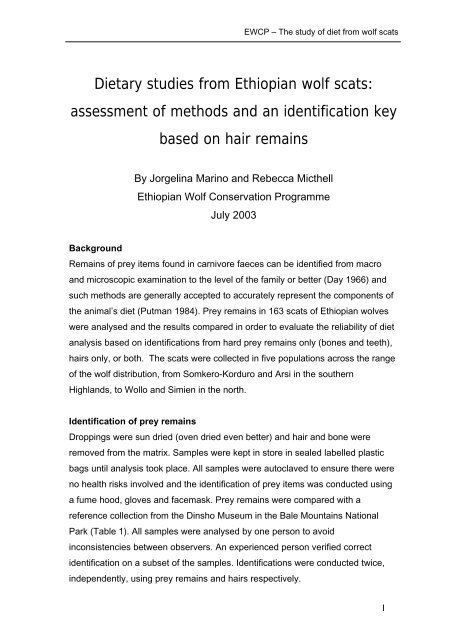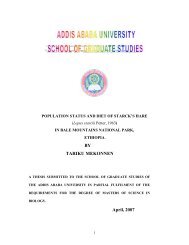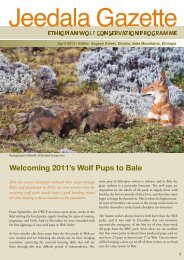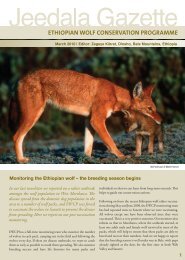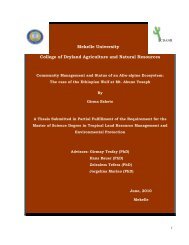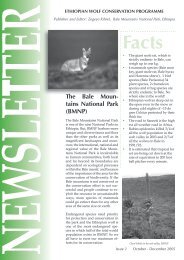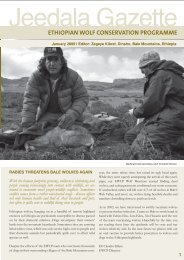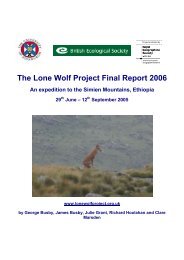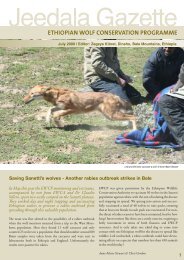EWCP Report - Feaces dietary.. - Ethiopian Wolf Conservation ...
EWCP Report - Feaces dietary.. - Ethiopian Wolf Conservation ...
EWCP Report - Feaces dietary.. - Ethiopian Wolf Conservation ...
- No tags were found...
You also want an ePaper? Increase the reach of your titles
YUMPU automatically turns print PDFs into web optimized ePapers that Google loves.
<strong>EWCP</strong> – The study of diet from wolf scatsDietary studies from <strong>Ethiopian</strong> wolf scats:assessment of methods and an identification keybased on hair remainsBy Jorgelina Marino and Rebecca Micthell<strong>Ethiopian</strong> <strong>Wolf</strong> <strong>Conservation</strong> ProgrammeJuly 2003BackgroundRemains of prey items found in carnivore faeces can be identified from macroand microscopic examination to the level of the family or better (Day 1966) andsuch methods are generally accepted to accurately represent the components ofthe animal’s diet (Putman 1984). Prey remains in 163 scats of <strong>Ethiopian</strong> wolveswere analysed and the results compared in order to evaluate the reliability of dietanalysis based on identifications from hard prey remains only (bones and teeth),hairs only, or both. The scats were collected in five populations across the rangeof the wolf distribution, from Somkero-Korduro and Arsi in the southernHighlands, to Wollo and Simien in the north.Identification of prey remainsDroppings were sun dried (oven dried even better) and hair and bone wereremoved from the matrix. Samples were kept in store in sealed labelled plasticbags until analysis took place. All samples were autoclaved to ensure there wereno health risks involved and the identification of prey items was conducted usinga fume hood, gloves and facemask. Prey remains were compared with areference collection from the Dinsho Museum in the Bale Mountains NationalPark (Table 1). All samples were analysed by one person to avoidinconsistencies between observers. An experienced person verified correctidentification on a subset of the samples. Identifications were conducted twice,independently, using prey remains and hairs respectively.I
<strong>EWCP</strong> – The study of diet from wolf scatsPrey speciesReference materialTachyoryctes macrocephalus HairsT. splendens Hairs and skullOtomys typusHairs and skullArvicanthis blickiHairs and skullLophuromys flavopunctatus Hairs and skullL. melanonyx Hairs and skullStenocephalemys albocaudata Hairs and skullStenocephalemys griseicauda Hairs and skullDendromus lovatiHairs and skullCrocidura fumosaHairs and skullC. baileyi HairsPraomys albipesSkullLepus starkiHairsHorse, sheep, goat & cattle HairsTable 1. Reference material available for the analysis of prey remainsThe examination of hairs, teeth and bones was successful in identifying preyitems to the level of species, with the exception of the species of Lophuromys andArvicanthis, which other studies found inseparable from hair and teethcharacteristics (Sillero-Zubiri and Gottelli 1995a). Hard remains were examinedby eye and under a binocular microscope and compared with teeth and jawbonesfrom the skull reference collection. Useful hard parts for rodent identificationswere large incisors, teeth and parts of the upper and lower jaws of rodents. Largebones, teeth and hooves were useful to identify larger prey.Figure 1. Types of hair and shield and shaft portions (the tip of the hair points to the left)Hairs differed in macroscopic characteristics such as size, shape andpigmentation, but microscopic examination of the cuticula of over hairs wasII
<strong>EWCP</strong> – The study of diet from wolf scatsnecessary for a definite identification (Figure 1). Standard procedures wereapplied to identify cuticular patterns from gelatine casts (Day 1966; Sillero-Zubiriand Gottelli 1994; Teerink 1991). A solution of gelatine was made up using 1teaspoon of gelatine crystals to 20ml of hot water. A small amount of the solutionwas poured on to a microscope slide and spread around to create a thin layer ofgelatine. Guard hairs (as described by Teerink, 1991) were selected and laid inthe same orientation on to the slide. When a film of solid gelatine formed as thewater evaporated, they were carefully lifted leaving the scats on the gelatine film.A reference set of scats was prepared from the reference collection. One or twoslides were created for each scat, using between 10 and 20 hairs per slide.Those include at least three hairs from “tuft” to ensure both an adequate print andthe inclusion of all prey items present in the sample. The casts were examinedunder 10x and 40x objectives of a compound microscope. The most usefulparameters for species identification were scale patterns in the shaft region of thehair (Figure 2) (following Teerink 1991), although in some cases the descriptionof the shield assisted with identifications. An identification key was created on thebases of diagnostic parameters easy to observe (unless otherwise stated, thecharacters used refer to scale patterns in the shaft region). This key can be ofmuch utility for future trophic studies in Ethiopia’s Afroalpine ecosystems.Identification key from hair remains1 a) Longitudinal petal pattern…………………………………………………………………………… 2b) Intermediate petal pattern…………………………………………………………………...……... 42 a) Very elongate petals with streaked regular wave in the shield………..…………... Lepus starkib) Narrow diamond petal pattern……………………………………………………………………… 33 a) Two or more scales wide……………………………………………………………... Otomys typusb) One scale wide...………………………………………………………………...Crocidura fuminosa4 a) Broad diamond petal pattern…...…………………………………………………………………… 5b) Mosaic pattern………………………………………………………………………………………... 85 a) Two or more scales wide…...……………………………………………………………………….. 6b) One scale wide with an irregular, rippled wave in the shield………………. Dendromus lovati6 a) Clear diamond petals intermediate in length with asmooth regular wave in the shield………………………………………..……… Arvicanthis spp.b) Elongate diamond petals with a less regular arrangement anda rippled irregular wave in the shield……………...…………………………………………….…….. 77 a) Regular arrangement, rippled wave in the shield …….………Stenocephalemys albocaudatab) Very irregular arrangement, smooth wave in the shield………Stenocephalemys griseicauda8 a) Two or more scales wide with a smooth regular wave in the shield….……….Lophuromys spp.b) One scale wide with irregular, rippled wave in the shield……… ……Tachyoryctes splendensIII
<strong>EWCP</strong> – The study of diet from wolf scatsFigure 2. Cuticular patterns used in identifications (the tip of the hair points to the left)(from Teerink 1991)IV
<strong>EWCP</strong> – The study of diet from wolf scatsComparison of methodsTable 3 shows occurrences of each species discriminating between those inwhich the prey was identified from hard remains only (mainly teeth), hairs only, orboth. The Mcnemar change test (Seigel and Castellan, 1988) can be used tocompare the effectiveness of the two methods by comparing the instances inwhich a species was identified by one method and not the other, with eachsample as its own control. To yield accurate results the test requires at least 10cases changing categories across the two variables, a requirement only nearlyfulfilled by the two commonest species O. typus. and Arvicanthis spp. For these,the null hypothesis of no difference in the likelihood of a prey item being detectedby hairs or hard remains was rejected (Chi-square 50.95, df 1, P=0.000 and Chisquare81.478, df 1, P=0.000).Teeth only Hair only Both All occurrencesT.splendens 8 4 1527O. typus 4 23 111 138Arvicanthis spp 7 12 3655Lophuromys spp 6 7 619S. albocaudata 6 7 215S. griseicauda 4 6 212D. lovati 1 3 610Table 2. Samples with one type or both types of prey remainsAn alternative way to explore differences between the three methods is comparethe relative contribution of occurrences over the total of occurrences for eachspecies (Figure 3). In the case of Lophuromys spp, S. albocaudata and S.griseicauda, the proportional contribution of occurrences from hair or teeth onlywas relatively high in comparison with other species, particularly O. typus andArvicanthis spp. Consequently, the total number of occurrences can be lower ifone prey remains is considered instead of both for some species, but if a similarnumber of occurrences is detected by one or the other (e.g. Lophuromys spp.)the resulting frequency of occurrence may be similar.V
<strong>EWCP</strong> – The study of diet from wolf scatsBothHair onlyTeeth only100%90%80%70%60%50%40%30%20%10%0%T.splendensO. typusArvicanthis sppLophuromys sppS. albocaudataS. griseicaudaD. lovatiFigure 3. Proportion of occurrences from hard remains (meanly teeth), hairs or bothFigure 4 shows the diet composition as described by the relative frequency ofoccurrence of each prey item (i.e. number of occurrences of a given prey dividedby all occurrences). Overall, the results were very similar when teeth only, haironly or both were used for the identification of prey in scats. Minor differencesreflected the fact that that species differed in whether more or less samples hadteeth only or hair only, but the relative importance of the contribution of preyspecies to the diet is clearly consistent between methods.VI
<strong>EWCP</strong> – The study of diet from wolf scats60%50%Teeth onlyHair onlyTeeth, hairs and both40%30%20%10%0%T.splendensO. typusArvicanthis sppLophuromys sppS. albocaudataS. griseicaudaD. lovatiFrequency of occurrenceFigure 4. Diet composition from frequency of occurrence of each rodent prey using threemethods of identification: hairs only, hard prey remains only (mainly teeth), or bothFinal assessment and recommendationsFor practical reasons, using hard remains or hairs for faecal analysis of the<strong>Ethiopian</strong> wolf diet will be equally effective, and examining bones is less timeconsuming. However, by using both, larger samples sizes will facilitate statisticalcomparisons, as the total number of occurrences is obviously higher when teethand hairs are analysed (n=276) in comparison with hairs only (n=240) or teethonly (n=214).Limitations to faecal analysis have been pointed out by several authors (Lokie1959; Reynolds and Aebischer 1991), but in the case of the <strong>Ethiopian</strong> wolf, themerits of the method are supported by previous studies that combined faecalanalysis, behavioural observations and estimates of prey availability andseasonal variations (Ashenafi 2001; Sillero-Zubiri and Gottelli 1995a). Aconsideration to take into account, however, is that the consumption of largerprey is under-represented in wolf scats when compared with hunting rates andcarrion feeding from direct observations. On the other hand, these studies foundno significant differences in main prey items between months or between dry andVII
<strong>EWCP</strong> – The study of diet from wolf scatswet seasons, indicating that differences in the time of the year in which thesamples are collected will not affect the final result.REFERENCESAshenafi, Z. T. 2001. Common property resource management of an Afro-alpinehabitat: supporting a population of the critically endangered <strong>Ethiopian</strong> wolf(Canis simensis). DPhil thesis, University of Kent, Kent.Day, M. G. 1966. Identification of hair and feather remains in the gust and feacesof stoats and weasels. Journal of Zoology, London 148:201-217s.Lokie, J. D. 1959. The estimation of the food of foxes. Journal of WildlifeManagement 23:224-227.Putman, R. J. 1984. Facts from faeces. Mammal Review 14:79-97.Reynolds, C. R., and N. J. Aebischer. 1991. Comparison and quantification ofcarnivore diet by faecal analysis: a critique, with recommendations, basedon a study of the Fox Vulpes vulpes. Mammal Review 21:97-122.Sillero-Zubiri, C., and D. Gottelli. 1994. Canis simensis. Mammalian Species:1-6.—. 1995a. Diet and feeding behavior of ethiopian wolves (Canis simensis).Journal of Mammalogy 76:531-541.Teerink, B. J. 1991, Hair of west european mammals, Cambridge UniversityPress.VIII


